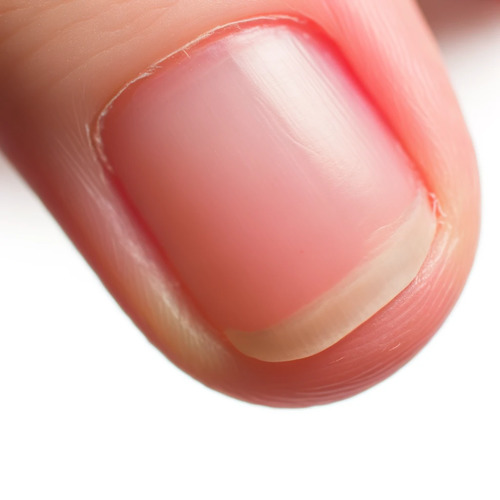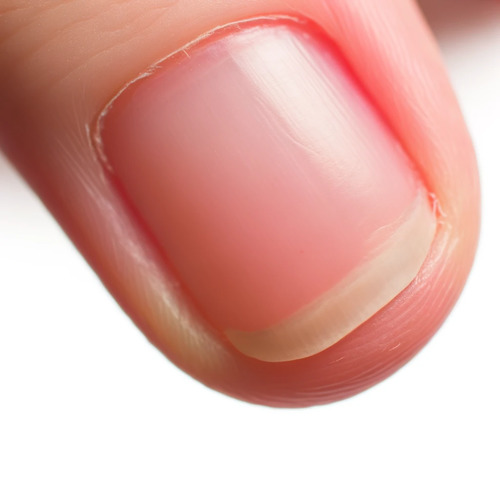Our nails have a complex anatomy, and every element of the nail (from the nail plate to the nail bed) plays an important role. The nail bed, in particular, is extremely important to the overall health and appearance of the nails. This is why protecting the nail bed from damage is crucial. To better understand its role and learn how to properly care for your nail bed, we recommend reading this article.
What is a nail bed?
The nail bed is an integral part of the nail's anatomy and plays a key role in its health and beauty. It is a structural formation that supports the nail plate, ensuring its strength, natural colour and texture. It extends from the top of the nail to the base of the nail, including the area from the "well" to the free edge. It is important to note that the nail bed contains blood vessels and nerve endings, as well as cells that produce keratin, which is the main component of the nail plate.
The nail bed carries not only a functional but also a protective load. It is part of the nail apparatus, providing protection for the fingertips and supporting fine motor skills, touch and grip. Understanding its role is important for both nail care professionals and those looking to keep their nails healthy and beautiful.
Why is the nail bed so important?
The nail bed, although hidden from immediate view, plays a key role in the beauty and health of the nails. It directly affects the shape, length and even the colour of your nails. Keeping it healthy not only contributes to the aesthetic appearance of the nails, but it is also an important protective barrier, preventing minor injuries. In addition, the nerve-rich structure of the nail bed provides sensory feedback, helping to prevent damage.
Regular care of the nail bed not only keeps it healthy, but also helps prevent problems such as ingrown nails and inflamed cuticles. It is important to remember that the nail can become an easy access point for various infections including bacterial, fungal and yeast infections. Therefore, it is important to monitor the condition of the nail bed and perform regular preventive treatments to avoid infections and related complications.

What can affect the condition of the nail bed?
The appearance and health of the nail bed can be affected by a variety of factors other than lifestyle. Some problems such as changes in the colour, texture or shape of the nails may indicate the presence of serious diseases or conditions. In such cases, it is advisable to consult a doctor specialising in dermatology. Self-treatment can be ineffective and may even aggravate the problem. Therefore, it is important to get a professional assessment of the condition of the nails and recommendations for further action.
Onycholysis
Onycholysis is a condition in which the nail bed separates from the nail plate. It usually occurs due to nail care mistakes, such as overexposure to tools or improper trimming. However, it can also be an indicator of serious health conditions such as hyperthyroidism, fungal infections, trauma or allergic reactions. Therefore, it is important to pay attention to this symptom and consult a doctor to identify the possible underlying cause and prescribe appropriate treatment.
Nail bed tumours
Although rare, nail bed tumours can be a serious condition and it is important to pay attention to them. They usually manifest as "clubbing," which is described as "an excessive curvature of the nail in the proximal and distal planes [or from top to bottom], forming a rounded bulge."
Melanoma
Melanoma appearing on the nail bed is particularly dangerous. A dark brown or black streak extending along the length of the nail, or brown pigment in the area of the nail fold, may appear benign due to changes in the skin, such as cuticle treatments that can stimulate pigment production. However, in rare cases, this may be the initial stage of nail melanoma. It is important to see a doctor immediately as soon as any suspected or unusual changes occur.
Psoriasis
Psoriasis is a condition that can appear on any part of the body, including the nail beds. Symptoms of nail psoriasis can range from onychlosis (detachment of the nail from the bed), thick and discoloured nail plates to redness, swelling and shallow indentations on the surface of the nail plate. Treatment may include the use of topical medications and targeted therapy. However, a doctor should be consulted to determine the most appropriate approach. He or she will help you find the best treatment for your individual case.
Trauma
In addition to the main conditions listed above, any trauma or injury to the nail bed can negatively affect its condition. A subnail haematoma, for example, occurs when the nail is injured and bleeding occurs in the nail bed. Blood can accumulate under the nail, and the increased volume underneath can lift the nail plate, causing pain. If the volume of haemorrhage is significant, the nail may even fall off completely.

How to care for the nail bed
1. Proper nail care
Regular nail care, whether at home or at a salon, plays an important role in maintaining healthy nail beds. Experts advise taking time for this process to keep your nails beautiful and strong. It is important to remember to keep the skin of your hands and feet moisturised, and to do this, use nourishing creams and special cuticle oils that contain biotin or keratin to promote optimal nail health. Be gentle when treating the cuticle, it is preferable to gently push it back rather than remove it. Use a fine grit file to smooth nails and try to avoid harsh ingredients in nail polishes and nail products to avoid damage and keep nails healthy for a long time.
2. Avoid aggressive cleaning and treatments
While it may seem tempting to clean out all the dirt trapped under your nail, it is highly recommended that you refrain from doing so. Introducing sharp tools under the nail plate can cause onycholysis, a condition in which the plate either lifts or separates from the nail bed. Cleaning too intensely under the nail can be harmful and cause potential infections. If the nail plate is separating from the nail bed, you should refrain from applying nail polish, using nail polish remover and nail extensions until the situation returns to normal.
It is also important to be careful with the cuticle. Aggressive cuticle removal can be detrimental to nail health, causing irritation, redness, soreness and inflammation of the nail bed, as well as increasing the risk of bacterial and fungal infections. The cuticle serves as an important protective barrier for the nail bed, and damage to it can weaken the overall structure of the nail, making it more susceptible to breakage.
3. Stop biting and picking your nails
Apart from the cosmetic aspects, the harm of nail biting habit extends to the health of the nail bed as well. Constant biting and picking can cause serious damage, tearing, bruising and even irreversible changes. As a result, there is a high risk of infections due to damaged skin, and constant trauma can disrupt the natural growth process, leading to deformities such as bumps and ingrown nails. Breaking these habits is critical to maintaining overall nail health and beauty.
4. Protect your hands
Every time you do the dishes, it may seem unnecessary to wear gloves. But professionals say that this small effort is worth it to keep your nails healthy. Keep your nails healthy by using protective gloves while cleaning and following proper hygiene to prevent infections.
Every time you do the dishes, it may seem unnecessary to wear gloves. But professionals say that this small effort is worth it to keep your nails healthy. Keep your nails healthy by using protective gloves while cleaning and following proper hygiene to prevent infections.
Conclusion
The nail bed is one of the key parts of the nail structure that determines their aesthetic appearance and overall health. It plays an important role in maintaining the health of the nail plate by serving as a protective barrier against minor injuries and problems. Despite its durability, the nail bed can be negatively affected by various factors such as repetitive trauma or medical problems, including onycholysis. If you notice changes in the appearance of your nail bed, it is important to carefully evaluate your current nail care practices and consult a medical professional.
Read also: How to properly care for cuticles at home?
